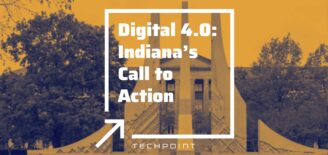Can Indiana get healthier through technology?
The amount of information about you, your habits and your health that is stored by various places you visit might surprise you. Whether it’s the grocery store, gym, bike-share service, family doctor or pharmacy, databases around town could offer you a remarkably clear picture of your personal health — IF they were unified.
Could Indy create a personalized healthcare platform that individuals, health providers and insurance companies could access? That was the hot topic at the second workshop in the “Indiana’s Opportunities to Lead in Digital Health” series.
This digital health series is sponsored by Ice Miller; and organized by Regenstrief Institute, hc1.com, and TechPoint. It leverages Indiana’s innovative healthcare information technology community, fostering innovative dialogue and strengthening industry connections between leading researchers, users and suppliers. The final sold-out workshop in the series is coming up in March, but TechPoint will be coordinating with the sponsors and partners to continue sharing information and developments from the events here at techpoint.org.
Can we do better at achieving wellness?
Dr. NiCole Keith, Research Scientist at the Indiana University Center for Aging Research and the Regenstrief Institute, shared that Indianapolis ranks 50th in the nation on the American Fitness Index, a data report that provides a scientific snapshot of the state of health and fitness at the metropolitan level.
Why is Indianapolis at the rock bottom? Dr. Keith offers three answers: low funding for public parks, weak requirements for physical education in our school systems, and our inability to report physical activity or behavior through data.
How do we go from being ranked 50th to first?
Dr. Keith suggests interfacing health behaviors and health records by tapping into where people currently share information about themselves. Kroger and Marsh know whether you are buying potato chips or zucchini when you use your rewards cards. Wearable technology companies track your physical activity much better than your own ability to remember the details of last night’s workout. Could that data be tied to personal health records that are accessible by your physician, personal trainer or insurance company?
So why hasn’t Indy tapped into this digital healthcare opportunity? Wearable technology companies have open APIs, but getting permission from the user is key. Dr. Titus Schleyer, Biomedical Informatics Scientist at the Regenstrief Institute, says “We know younger people are willing to share their information to the cloud, but older people and those in rural communities are very concerned with who has information about them and why.”
Are we doing better or worse than before?
“I think Indy is doing a great job compared to where we were 10 years ago,” Dr. NiCole Keith said. “With bike lanes and improved infrastructure, people can feel comfortable being a pedestrian or cyclist.”
Indianapolis is making a dedicated effort to increase public health. In 2015, residents and visitors took 116,000 Pacers Bikeshare trips and logged 240,000 miles. The Cultural Trail continues to win awards and act as the standard for other cities interested in incorporating similar trails. Capturing that data from multiple sources and incorporating it into a comprehensive health data package continues to present challenges.
“A lot of healthcare information can be collected, but we should not compete for information. We have the ability to share information on fitness at a community level so we can all draw from that activity and really move the needle from 50 to 1,” Dr. Titus Schleyer said. “We can either lead or let this opportunity pass by.”
TAKEAWAYS
Perspectives from Titus Schleyer, DMD, PhD. – Biomedical Informatics Scientist, Regenstrief Institute
Indiana’s Opportunities to Lead in Digital Health: Can we do better at achieving wellness? Leveraging HIT.
Nicole Keith from IUCAR and Julie Daftari from UnitedHealthCare gave excellent presentations putting wellness and what we can potentially achieve with health IT into context. We had about 60 attendees from organizations such as Regenstrief, Eskenazi Health, IU Health, local healthcare IT companies, the ISDH, IUPUI and TechPoint.
The workshop centered around several main points:
- Indiana is doing quite a bit in terms of promoting health and wellness, but that does not tend to be reflected in our national rankings, which are quite low.
- There are some really cutting edge initiatives for health and wellness locally (e.g. Pacer bikeshare program, bike lane infrastructure in the city and elsewhere, community gardens, etc.).
- While person-generated health and wellness data are not always reliable, they do have value. They often can contribute to clinical assessment and decision-making, and it’s better than not having the data (e.g. the patient having to recall their level of physical activity).
- From a technology perspective, interfacing personal health devices, such as Fitbit, Jawbone, glucometers, etc., with electronic health records or the Indiana Network for Patient Care (INPC) is not a huge challenge.
- There are various opportunities for engaging people in their health using electronic methods, such as email, portals, apps and social networks.
- We don’t yet have a lot of information about how effective these venues are for engaging people in their health and what the clinical outcomes are.
The audience engaged with these topics quickly and intensively. The ideas/comments generated during the discussion period included:
- An INPC-based personal health record might be an extremely strong proposition for patients, especially those who seek care at more than one healthcare institution. Who wouldn’t like to see all of his/her health information in a central place instead of having to visit several system-specific portals?
- Integrating patient-generated data, wellness data, and environmental and other data into the INPC could do much for providing a platform for keeping Hoosiers well instead of just focusing on them when they are sick. Most of us tend to share data about ourselves (e.g. purchasing habits in grocery stores or location of our cell phones) fairly freely – it would be intuitive that we would also be willing to do that for our health. Doing this successfully could put us in the lead nationally in trying to keep a state healthy.
- I would love to see the day when the Indiana tech community and others could innovate on top of the INPC. Not only could this create tremendous economic value, it could also promote health in ways that few other places can.
- We should not compete with each other on health information. We need to share health information for the betterment of our community.
- How do you integrate patient generated data into the general clinical/health care workflow? The health care workflow isn’t really built to accommodate these data — nor are clinicians used to integrating them into their decision-making.
- The issues we are talking about are not really technology problems — they are much more people, policy, cultural and societal issues.
- We need alignment of the players, such as hospital systems, payers, government, IHA, IBRI, RI, IHIE, etc. to get some of these ideas done.
- We underestimate the power of the consumer. We are now seeing changes in society that wouldn’t be possible without large-scale engagement and communication of consumers. This will also affect what we do with healthcare data.
What is your single biggest concern regarding the health of Hoosiers? What is the #1 opportunity you see for tech to help improve the health of Hoosiers? Please share your thoughts in the comments section below.






































